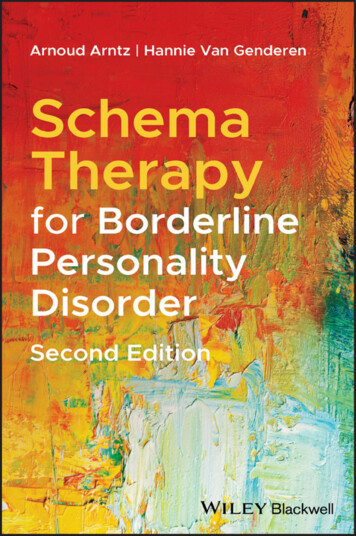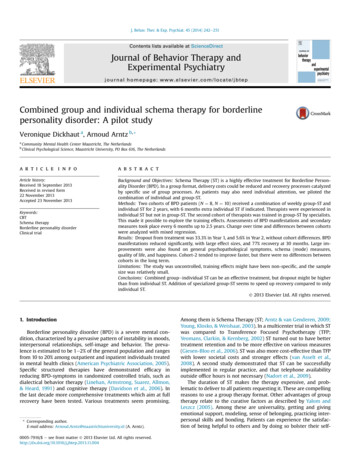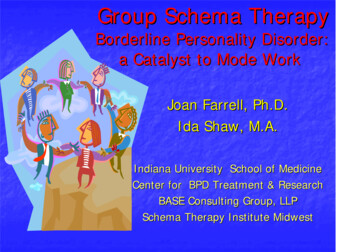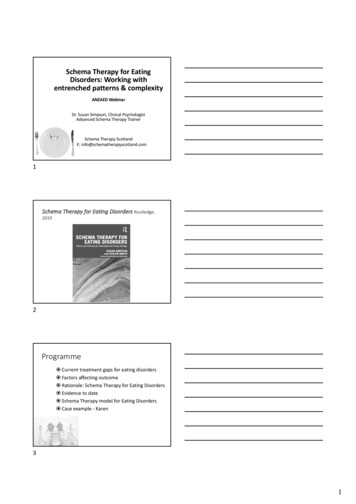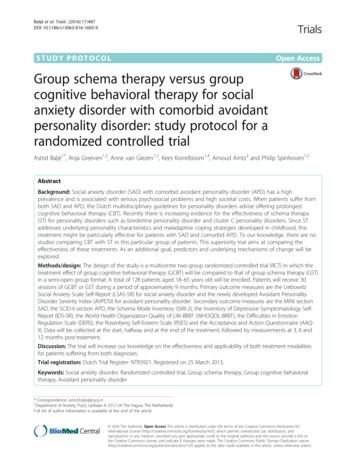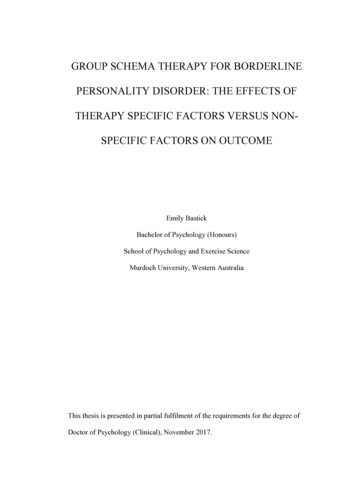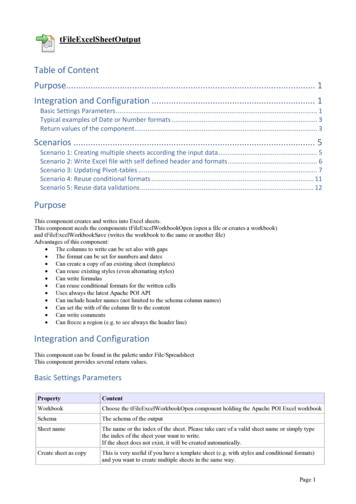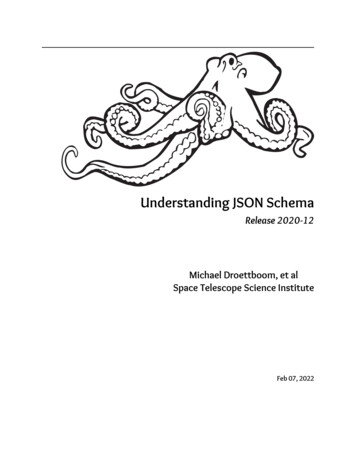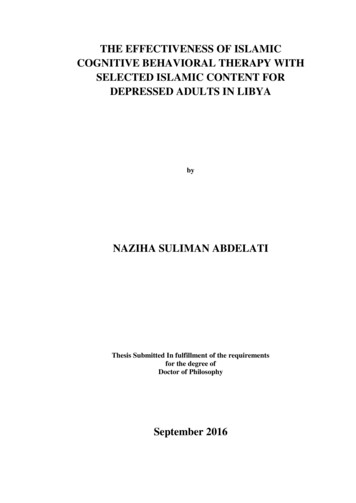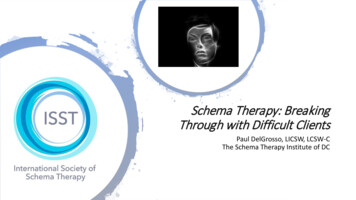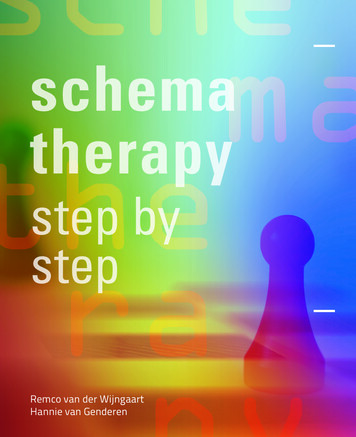
Transcription
schematherapystep bystepRemco van der WijngaartHannie van Genderen
IntroductionSchema therapySchema therapy is an integrative form ofpsychotherapy developed in the 1990sby Jeffrey Young. In several treatmenttrials, schema therapy proved to beeffective in the treatment of personalitydisorders and persistent anxiety andmood disorders.Schema therapy assumes that duringtheir youth every person developsschemas through an interplay of factorssuch as the temperament of the child,biological and social factors. Whenthere are chronic deficits in validatingthe basic needs of a child, theseschemas are colored by feelings of fear,uncertainty, mistrust, etc. These arecalled maladaptive schemas in thesense that the extreme overwhelmingemotions lead to symptoms andinterpersonal problems. Young describes18 such maladaptive schemas and threekinds of survival strategies and copingstyles.Patients display continued fluctuatingmoods; the patient can start talkingquietly only to be swept up in a sad orangry, self-reproachful mood the nextmoment. Such moods are called schemamodes, modes or ‘sides’ of the patient;specific schemas and coping stylesdominate one minute while the nextother schemas and other coping stylesdetermine the mood.In the first phase of the treatment,schema therapy focuses on learning todistinguish and recognize such modes.The majority of the treatment isconcentrated on re-working thosemodes so that the patient develops amore realistic self-image and view of theworld and is better able to validate his/her basic needs so that the patient feelsmore secure, more confident or moreconnected with others. The mostimportant therapeutic instrument usedby the schema therapist is the therapyrelationship of Limited Re-parenting; thetherapist acting as a role model of thegood enough parent that the patientshould have had as a child. The therapistfurthermore uses cognitive, experientialand behavioral techniques and focuseson meaningful experiences in the past,as well as on the present and future.This production follows the wholeprocess of schema therapy from thefirst to the last session. Although inthe course of the curriculum you dolearn what the various componentsof schema therapy are, the applicationof these components in the differentphases of therapy often raisesquestions.The purpose of this production is tofamiliarize novice therapists with allaspects of schema therapy. Thetreatment of a client with a BorderlinePersonality Disorder is shown in 91scenes. All steps of the schema therapyprocess are shown. It starts by makinga case conceptualization, introducingschemas and modes, discussing theresults from the questionnaires andusing experiential techniques in thisphase. Methods and techniques willthen be shown in the different phasesof the treatment; start phase, therapyphase and end of the therapy.To teach therapists how to recognizeschemas and modes, they aredemonstrated in short fragments.3 schema therapy step by stepFinally, there are various exercises inwhich the viewer is invited to considerhow he/she would better deal withthe session which was shown.In this booklet, you will find anexplanation with useful additionalinformation for each scene shown.This production can be used as anintegral part of a course on schematherapy or as a supplement to training,supervision or intervision.
Contents1Start phasemin1.01 Getting started: exploringpatterns and schemas(7:49)1.02 Discussing the scores on the YSQ (6:15)1.03 Diagnostic Imagery(12:20)1.04 Introducing modes(5:13)1.05 Discussing the mode model(8:54)1.06 Discussing goals of therapy(7:27)1.07 Mode guessing game(8:31)2Treatment Phase2.01 Limited Reparenting Offering care(8:56)2.02 Limited Reparenting Providing direction(6:09)2.03 Limited Reparenting Empathic Confrontation(7:10)2.04 Limited Reparenting - Limit setting (9:30)2.05 Detached Protector - Chairwork (10:09)2.06 Historical role play(16:00)2.07 Bully & Attack - Empathicconfrontation(6:19)2.08 Punitive Parent Imagery rescripting(12:50)2.09 Bullying Peers Imagery rescripting(9:42)2.10 Punitive Parent - Chairwork(8:24)2.11 Punitive Parent Cognitive technique(11:19)2.12 Vulnerable Child Circle Diary Form(9:15)2.13 Vulnerable Child - Audio flashcard (4:04)4 schema therapy step by step2.14 Vulnerable Child - Set homework (7:57)2.15 Angry Child - Ventilate,Empathize, Reality testing(8:12)2.16 Angry Child - Chairwork(9:24)2.17 Structure of complete sessionwith transitions to black(10:59)3End phase3.01 Empathic Confrontation(3:04)3.02 Detached Protector - Chairwork:coaching Healthy Adult(8:12)3.03 Detached Protector - Chairwork:therapist plays coping mode(5:42)3.04 Punitive Parent - Chairwork(6:17)3.05 Punitive Parent - ImageryRescripting(8:37)3.06 Healthy Adult - Identifyingthe Healthy Adult(8:13)3.07 Healthy Adult - Psychoeducation (4:08)3.08 Future Imagery - Mode awareness& mode management(9:54)3.09 Future Imagery - Behavioralchange(8:13)3.10 Homework assignments(5:44)3.11 Healthy Adult - Dealing 8Examples of schemasMistrust/AbuseEmotional DeprivationAbandonmentSocial IsolationDefectiveness/ShameSocial )(0:25)(0:52)(1:05)(0:41)(0:46)(0:51)4.09 Vulnerability to Illness & Harm4.10 Insufficient Self-control/Self-Discipline4.11 Entitlement/Grandiosity4.12 Unrelenting Standards4.13 Emotional Inhibition4.14 Self-sacrifice4.15 Subjugation4.16 Enmeshment4.17 25.23Examples of modesVulnerable ChildAngry ChildEnraged ChildImpulsive ChildUndisciplined ChildHappy ChildCompliant SurrenderDetached ProtectorDetached Self-sootherAvoidant ProtectorAngry ProtectorSelf-aggrandizerBully & Attack 1Bully & Attack 2PredatorPerfectionistic Over - ControllerParanoid Over - ControllerConning and Manipulative ModeApproval SeekingPunitive ParentDemanding ParentGuilt-inducing ParentHealthy Adult(1:00)5 schema therapy step by 02)6Exercises6.01 Exploring patterns & schemas -exercise(5:09)6.02 Identifying different schemas -exercise 1(5:48)6.03 Identifying different schemas -exercise 2(6:02)6.04 Identifying different modes -exercise 1(1:12)6.05 Identifying different modes -exercise 2(2:05)6.06 Discussing the scores on theYSQ - exercise(3:19)6.07 Diagnostic Imagery - exercise(6:04)6.08 Offering care at start oftherapy - exercise(3:01)6.09 Providing direction at thestart of therapy - exercise(4:04)6.10 Empathic Confrontation -exercise 1(2:13)6.11 Empathic Confrontation exercise 2(3:27)6.12 Limit setting - exercise 1(2:07)6.13 Limit setting - exercise 2(1:47)6.14 Schema interactions - exercise(2:55)6.15 Mode interactions - exercise(2:25)6.16 Chairwork: fighting the punitiveantagonist - exercise 1(4:04)6.17 Chairwork: fighting the punitiveantagonist - exercise 2(1:50)6.18 Dealing with anger - exercise 1(1:16)6.19 Dealing with anger - exercise 2(0:55)6.20 Dealing with anger - exercise 3(1:35)
Explanation of the scenes1 Start phase1.01 Getting started: exploringpatterns and schemasLimited reparenting is entering into thetherapeutic relationship as if you werea sort of parent of the client who iscaring and helps her1 discover how shecan best deal with difficult things.That means personal and open contact.That starts at the beginning of therapy;be yourself as much as possible, thinkaloud so as to offer sanctuary, explicitlystate that you will do your best to makethe therapy a safe place. A start is madewith identifying basic needs.Exploring schemas means alternatingbetween talking about concrete examplesand then broadening to general patternsand the use of a downward arrowtechnique and a diagnostic imagination.1.02 Discussing the scores on the YSQThe feedback of the results from thequestionnaires can best be integrated inthe conversation about the complaintsand experiences. By delving into anexperience of the client, the discussionof a schema is more involving. Discussing1. Where it says ‘she’, you may also read ‘he’. In thisinstance, we are using ‘she’ because the client in therecordings is a woman.6 schema therapy step by stepthe schemas must encompass morethan just stating the names of theschemas; these names represent adeeply felt experience. Describing thatexperience helps the client to recognizeher relevant schemas and to experiencethat the therapist understands her.1.03 Diagnostic ImageryDo not wait too long to introduce a firstdiagnostic imagery exercise. An imageryexercise can be done in the first orsecond session (latest). This first phaseis only aimed at exploration of theschemas and modes. The imageryexercise is thus still without rescripting.There are two ways to introduce theexercise; it can simply be announced asan exercise or a link can be made to whatthe client is telling us. In the latter case,the imagery exercise is a tool to betterunderstand why the client is so affected.The explanation regarding the methodshould not be too long; it is better togenerate an experience and afterwardscognitively discuss what has happened.However, it is helpful for the client toinform her about the duration of theexercise and to emphasize that theclient retains control at all times.First creating a safe place is not strictlynecessary but it is an easy way to getthe imagination going. The emotionalbridge should describe the emotional,cognitive and physiological aspects inorder to generate underlying, meaningfulmemories as best as possible.1.04 Introducing modesThere are different ways in which modescan be introduced. A natural way is toconnect the modes to the perception ofthe client. Discussing the repression offeelings, in contrast to overwhelmingfeelings at other times, can lead to adiscussion of two different sides of theclient. You can then search for names forthose sides that fit the client’s perception.Do not just name the different sides butsupport that with gestures as if you arepointing to different people.1.05 Discussing the mode modelYou share the mode model with theclient and together you can build on it inthe session. The aim is to visualize thedifferent modes, generating more insightand overview, also by typifying theexperience per mode. By varying the sizeof the modes, you can better match theexperience of the client. One client, forexample, has a very strong, and thussignificant, protector, the other a verystrong and significant Punitive Parent.1.06 Discussing goals of therapyBe clear about the objectives in thetherapy. That is: negotiating with the7 schema therapy step by stepProtector, fighting against the PunitiveParent and providing for the needs ofthe Vulnerable Child and the Angry Childin order to strengthen the Healthy Adultside of the client. It helps to present thismessage clearly, in simple terms.The client does not yet have a HealthyAdult side that is able to understand acomplex explanation. Here again, thequestion “How would I explain this to achild who feels sad and anxious?” canbe helpful. At this initial stage of thetherapy, only limited agreements aremade about the therapy conditions onthe basis of the same assumption thatthe Healthy Adult side of the client isnot strong enough to make this type ofagreement.1.07 Mode guessing gameOne of the most important goals in theinitial phase of therapy is that the clientlearns to recognize the modes andincreasingly learns to think in terms ofmodes. The ‘guess-the-mode’ game isa somewhat lighter way to achieve thisgoal. The nice thing about this methodis that more attention can be paid tothe non-verbal signals of the modes.The question of whether the clientwants to engage in the modes herselfinvites the client to immerse herself inthe modes and for that she needs tobecome more aware of all the differentcharacteristics of the modes.
2 Treatment Phase2.01 Limited Reparenting Offering careIn the first place, good care meansconnecting with the client’s experience.To this end, it helps to keep the image ofthe client as a small child in mind.On an emotional level, the client isoverwhelmed by old pain from herchildhood. The leading question for thetherapist can then be: “What would I do/say if this were really an upset child?”.The answer is not to come up withsolutions immediately but to firstacknowledge what the client feels and,where possible, make a connectionwith her experiences from the pastthat exacerbate the emotions. Careoften means a soft, warm tone of voice,a slow pace and reassurance, ratherthan suggesting well-meaning solutions.State that it is good that the client nowdares to talk about it and ascertainwhether she has thought about thecrisis plan.2.02 Limited Reparenting Providing directionLimited Reparenting means, amongother things, that you, as a therapist,interfere in a personal and activemanner with the important life choices ofthe client. The only emotion-regulatingmechanisms that clients have are thecoping styles of overcompensation,8 schema therapy step by stepavoidance or surrender. In thesebehavioral reactions, scant attention ispaid to what is felt, what the underlyingneeds are and what the exact problemis. The switch ‘to action’ is immediate.Giving direction often means slowingdown and sympathizing and in themeantime actively thinking about whatcould change in the important areas oflife in the longer term.2.03 Limited Reparenting Empathic ConfrontationLimited reparenting does not onlymean caring and directing, it also meansconfronting in an empathic mannerbehavioral patterns that are not helpfuland that prevent the basic needs of theclient from being fulfilled. An empathicconfrontation can be conducted indifferent ways, but within LimitedReparenting it means at leastconfronting in a personal way.The following step-by-step plan can helpto shape the empathic confrontation:1 the therapist examines for him-/ herself which behaviors interfere incommunication.2 the therapist confronts the clientin a friendly but clear way.3 do this in small steps and contemplatethe emotions this calls up.4 expand this example to a broaderpattern of behavior.5 make a connection with the historicalbackground and the modes that havedeveloped as a result.6 appoint a healthier alternative that ismore in line with the needs of the client.2.04 Limited Reparenting - LimitsettingDrawing a limit also implies that thereare consequences if that boundary is notrespected. These natural consequencesare announced in advance. The next timethe problem behavior occurs, it is againexplained why the boundary is thereand the consequence is put into effect.If necessary, these consequencesincrease in severity up to the point thatthe therapy is interrupted or stoppedaltogether.2.05 Detached Protector - ChairworkThe therapist uses chairwork to explainthe protective function of the detachedprotector. The therapist then tries tobypass the Detached Protector andconnect to the Vulnerable Child.The therapist identifies the DetachedProtector in the session.The therapist asks the patient to moveto another chair and explain, as theDetached Protector, how this copingmode is helpful for the patient.The therapist points out that theDetached Protector is not solvinganything and offers a different, morehealthy approach.The therapist then asks the patient to9 schema therapy step by stepmove back to the original chair next tohim and tries to connect to theVulnerable Child, reassuring andcomforting her.If necessary the therapist asks thepatient to go back for a short while tothe chair of the Detached Protector tohear new arguments.Finally, the therapist asks her to returnto the chair next to him to connect to theVulnerable Child again.2.06 Historical role playThe historical role play consists ofseveral phases:1 identification of behavioral patterns,schemas in which the client getsstuck and preliminary discussionabout a meaningful past situationthat underlies the schemas.2 reenactment of this historicalsituation in which the client playsherself (as a child) and the therapistthe other (father).3 discussion of the role play andidentification of the learnedassumptions about herself and/orthe other.4 reenactment of the historicalsituation in which the client plays theother (father) and the therapist playsthe client as a child. The therapistclearly indicates the father’scircumstances at the time, so thatthe client can play the father of thattime as best as possible.
5 Discussion of the role play. Thetherapist first asks the client questionsin the role of father and checks whetherthe father really thinks what the clientinitially concluded. Then test thecredibility of the assumptions again.Then discuss how the client wouldwant to respond in the historicalsituation, but with today’s knowledge.Emphasize that the desired behavior inthe past was not yet possible, but thatshe can try it out now.6 reenactment of the historicalsituation in which the therapistplays the other (father) and theclient stands up for her needs.7 discuss this experience and give a lotof affirmation for what the client hastried. Together formulate the otherperspective (father cannot bereasoned with) and an alternativeconclusion about herself (I can givemy opinion). This builds healthyschemas.2.07 Bully & Attack-EmpathicconfrontationThe therapist uses the same stepswhen doing an empathic confrontation.The Bully & Attack mode, like any otherform of overcompensating coping mode,has an escalating effect, easily triggeringthe therapist to start to talk faster orto argue. The therapist has to deescalate by looking away from time totime, giving small summaries with10 schema therapy step by stepexplicit understanding of the patient’sfeelings, trying to keep a clam tone ofvoice.2.08 Punitive Parent - ImageryrescriptingWith rescripting, there are differentvariations in the use of imagination.For example, the therapist can first startwith a safe place or directly engage withthe upsetting feeling that the clientalready has or directly evoke a pictureof a recent situation that caused a badfeeling or directly go to a meaningfulimage from the past.In the most comprehensive variant,the steps are:1 explanation of aim and method2 safe place3 recent trigger situation4 emotional bridge to the past5 visualization of the originalmeaningful event6 rewrite that event7 back to the safe place8 post-discussion.2.09 Bullying Peers - ImageryrescriptingSometimes the antagonists in thehistorical situation are not a parent butpeers. In these situations, the therapistmust decide if he addresses the bullyingchildren, and/or the teacher who mightbe involved in the situation.2.10 Punitive Parent - ChairworkSending away a Punitive Parent modeusing the multi-chair technique hasseveral steps:1 Identifying and naming the PunitiveParent mode.2 Place the client in another chair andask her, from this punitive experience,to indicate what is wrong with theclient. Let her say it to little Sandra(empty chair).3 Interrupt these punishing messagesafter a few sentences and ask theclient to sit next to you. Indicate thatthe punishing side stays behind onthat other chair.4 Explore the emotions of the VulnerableChild and, if possible, identify thehistorical roots of the Punitive Parent.5 The therapist addresses thePunitive Parent with the strengthnecessary to win.6 Regularly check the client’s feelingsand after a few attempts to silencethe Punisher, put the Punisher’schair out of the door if necessary.7 Comfort the Vulnerable Child.8 Round off with a cognitive frameworkin which the Healthy Adult willunderstand more about whathappened.2.11 Punitive Parent - CognitivetechniqueWhen challenging the (messages of)the Punitive Parent, it is also important11 schema therapy step by stepto submit arguments that show thatthe Punitive Parent is not right.Cognitive techniques offer anopportunity to explicitly highlightthese arguments, such as a moredimensional evaluation in this scene.There are several variations on thistechnique and for a description of thisreference is made to literature fromcognitive behavioral therapy.2.12 Vulnerable Child - Circle DiaryFormClients have a tendency to have extremereactions at an emotional, but also at acognitive level, under the influence oftheir modes and schemes. They drawconclusions that are incorrect orpremature, without examining whatalternative explanations there might befor a difficult situation. In this fragment,together with the client, we go over herfirst automatic reactions and thoughtsafter a friend cancelled an appointment bymaking a cognitive circle. We look at theinfluence of the dysfunctional thoughts onher feelings and behavior and what thereal need was. This creates a morenuanced view of the whole situation.2.13 Vulnerable Child - Audio flashcardRecording an audio flashcard as atherapist has several advantages.On the one hand, it provides a tool forthe client to remember and furtherinternalize the factual arguments
against parent mode. On the otherhand, a recording with the voice of thetherapist who says nice things is alsoa transitional object, which helps tofurther internalize the therapist.2.14 Vulnerable Child - Set homeworkThe therapist gives homeworkassignments at the end of every session,right from the start of therapy. In thefirst phase of therapy, the therapistsuggests homework that is aimed at abetter understanding of modes andthat the therapist, and the therapist’smessages and the use of an audiotapeand diary forms are helpful in achievingthis.2.15 Angry Child - Ventilate,Empathize, Reality testingIn the Angry Child mode, not only is theanger felt about the current triggersituation but also the pent-up angerabout all the injustice which the clienthas experienced in the past. If the clienthas never been given the opportunity toexpress this anger, then ventilating allanger in the session is very healthy asit validates the suppressed need forself-expression. Note that this strategyworks in child modes and not in copingmodes. Furthermore, the strategy ofventilating-empathizing-reality testingshould be adapted if other basic needsthan self-expression are relevant to yourclient.12 schema therapy step by step2.16 Angry Child - ChairworkAt the start of the therapy, the emphasisin handling the Angry Child is to ventall the old anger. In the later stages oftherapy, the Healthy Adult should learnto express the anger in a different wayso that the connection with others isnot harmed. The therapist coaches theHealthy Adult in expressing anger in acontrolled manner.2.17 Structure of complete sessionwith transitions via blackListen carefully at the beginning of thesession as to which mode is active. Thatcan be heard, among other things, by thetone of voice and the way in which theclient talks about herself. Choose astrategy that suits that particular mode:in coping mode you want to circumvent,in parent mode you want to challenge,the Angry Child should get a chance tovent all anger and the Vulnerable Childshould be validated in her basic needs.In one session, multiple techniques canbe applied depending on the process inthe session. At the end of the session,time should be allowed to cognitivelyanchor all experiences and the therapistwill address the Healthy Adult moreexplicitly. Homework is given at the endof each session.3 End of Therapy3.01 Empathic ConfrontationIn the final phase of therapy, the empathicconfrontation may be somewhat clearerthan at the beginning. The therapeuticrelationship is strong enough for thisand the client can appeal more to herHealthy Adult. The therapist speaksmore clearly to the Healthy Adult, namesthe modes he hears and tries to let herHealthy Adult take control. Addressingthe Healthy Adult is accompanied by adifferent tone of voice than in thebeginning of therapy and the therapistwill address the Healthy Adult moreexplicitly about her responsibilities.3.02 Detached Protector - Chairwork:coaching the Healthy AdultIn the final phase of therapy thetherapist coaches the Healthy Adultmode of the patient in bypassing hercoping mode.The therapist identifies that the copingmode is present in the session andasks the patient to sit in another chair.The patient explains the pro’s of thecoping mode.The therapist then asks the patient tomove to the original chair beside himand asks the patient to argue using thecoping mode from a Healthy Adult pointof view.If necessary, he asks the patient to moveback to the chair of the coping mode.13 schema therapy step by stepFinally, the patient concludes from theHealthy Adult mode that she wants thecoping mode to take a step back moreoften in the future.3.03 Detached Protector - Chairwork:therapist plays coping modeStrengthening the Healthy Adult at thefinal phase of therapy requires thepatient to argue with her coping modeherself. The therapist plays the copingmode, at the same time supporting andcoaching the patient in expressinghealthy arguments.The therapist introduces the exercise asa way of strengthening the HealthyAdult side.The therapist takes a place in the chairof the coping mode and starts explainingwhy this side is helpful.The patient has to oppose this copingmode with specific arguments.If needed, the therapist supports thepatient in the role of the Healthy Adult.The therapist goes on until the patienthas refuted all the arguments of thecoping mode.3.04 Punitive Parent - ChairworkAt the end of the therapy the role ofthe therapist is more coaching thandirecting; the Healthy Adult side ofthe client must now learn to fight thePunitive Parent. The therapist’s coachingmay entail that words are still proffered,encouragement given to repeat certain
statements or to repeat them moreforcefully. Saying these argumentsagainst the punisher out loud alsomakes these arguments more believable.3.05 Punitive Parent - ImageryRescriptingImagery with Rescripting. In the finalphase of therapy, the therapist uses theHealthy Adult in rescripting. This is donein three steps:1 First, the client makes contact withthe original situation, in which she isthe child (little Sandra) whoexperiences the unpleasant situation.2 The scene then reverts to thebeginning, but the client assumes therole of her Healthy Adult (Big Sandra)and she intervenes until it is safe forlittle Sandra. Finally, she comfortslittle Sandra.3 Again, the scene reverts to the beginning and now the client is againlittle Sandra, who experiences whatSandra does to protect and comfort her.This scene starts with the first step.It can be helpful to start theimagination exercise by visualizingthe Healthy Adult so that this mode isalready somewhat activated. Thismakes it easier to visualize thatHealthy Adult in step 2.3.06 Healthy Adult - Identifyingthe Healthy AdultThroughout the entire therapy, work is14 schema therapy step by stepbeing done to strengthen the HealthyAdult. Initially this is primarily throughexperiential techniques and psychoeducation. In the final phase of thetherapy, what the client can do to makecontact with her Healthy Adult isdiscussed more explicitly. One of thepossibilities is that when confrontedwith a difficult situation, the client willthink back to an image in which shesoundly resolved something through herHealthy Adult. During the visualizationof the Healthy Adult, attention is paid tothe various attributes of this mode suchas the physical posture, cognitions,emotions and physiological aspects thatbelong to the Healthy Adult. Finally, it isdiscussed how this side differs from thedysfunctional modes.3.07 Healthy Adult - Psycho-educationThe therapist gives psycho-educationabout a healthy adult way in coping withdifficult situations in three steps:1 Pay attention to your emotions andbe kind and accept what you feel.2 Be aware of coping and or parentmodes that try to interfere.3 Reality testing: What do you need, andwhat action validates these needs?3.08 Future Imagery - Modeawareness & mode managementThis imagery exercise in this final phaseof therapy is focused on strengtheningthe healthy adult and becoming awareof the dysfunctional modes that caninterfere. The patient learns how toreconnect to her Healthy Adult, whenthe other modes try to take over.3.09 Future Imagery - BehavioralchangeThe final phase of therapy increasinglyfocuses on the necessary behavioralchanges and the client must prepare forpossible trigger situations in the future.Imagination exercises in this phase oftherapy are now mainly used to visualizethe Healthy Adult handling thesechallenging situations.1 Pre-discussion of old modes and thedesired behavior in trigger situations.2 Visualization of a likely triggersituation and feeling the old reactions.3 Making contact with the HealthyAdult and visualizing the desiredresponse.4 Repetition of this Healthy Adult helpsto better internalize this.3.10 Healthy Adult - Dealing withconflictDifferent modes were activated uponconfrontation with a challenging andtriggering situation. The therapist isnot pointing out the modes anymorebut pushes the Healthy Adult to identifythese modes herself. He then pushesher to comfort little Sandra and practicethe three steps of the Healthy Adult.15 schema therapy step by step3.11 Homework assignmentsWhen the patient has learned tomanage conflict situations from theHealthy Adult side, the therapist givesher homework to rehearse managingthese conflicts in this way, wheneverthey occur again. He also points out thatit is possible that she will not alwayssucceed. Consequently, her otherhomework is that she has to fill in adiary form about a situation thatdidn’t go well.After three weeks, the patientdiscusses the way she handled twoconflict situations.The therapist compliments her for thethings that went well. They also discussthe fact that she didn’t fill out the diaryform after a conf
of schema therapy are, the application of these components in the different phases of therapy often raises questions. The purpose of this production is to familiarize novice therapists with all aspects of schema therapy. The treatment of a client with a Borderline Personality Disorder is shown in 91 scenes. All steps of the schema therapy
